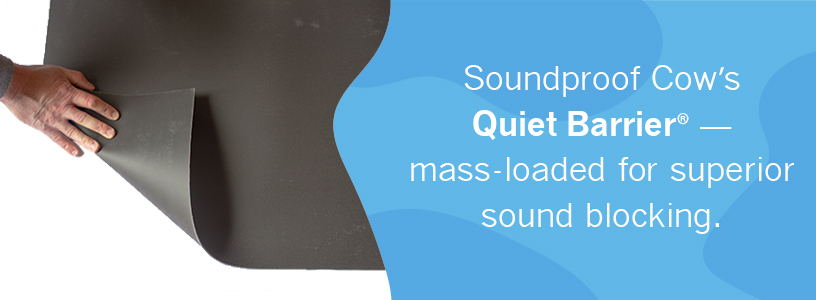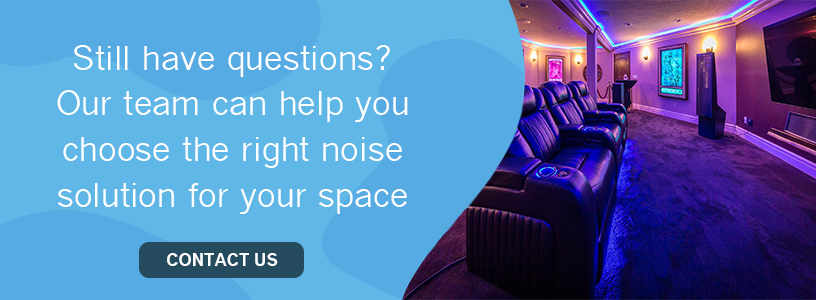
What Are Noise Barriers?
Noise barriers are dense materials or systems engineered to block airborne sound transmission between spaces. Whether you are managing noise at home, in a business, or at a commercial facility, noise barriers serve a single, crucial function: reduce unwanted sound transfer through walls, ceilings, floors, or even from outdoors into your building.
You will often hear “noise barrier,” “sound barrier,” and “acoustic barrier” used interchangeably. All refer to dense materials or systems that block airborne sound by adding mass to a structure. The added weight makes it harder for noise to pass through walls, floors, or ceilings.
A critical distinction: Noise barriers are not the same as sound absorbers. Barriers are used to block sound from leaving or entering a space. Absorbers, such as acoustic panels or foam, are used to control echo and improve acoustic clarity within a room. Both are essential, but each has a specific role in a complete soundproofing plan.
How Noise Barriers Work

Noise barriers work by introducing mass and density into walls, ceilings, or floors. This extra weight reduces vibration and limits how much sound can pass through. Most noise barriers primarily block and reflect airborne sound, while advanced barrier composites may also contain damping layers that dissipate a small amount of vibration energy as heat—further reducing noise transmission.
Proper installation is vital: Even the highest-performing material will not deliver results if gaps, seams, or structural flanking paths are left unaddressed. At Soundproof Cow, we always emphasize the importance of sealing every joint and penetration with acoustic caulk or tape to ensure continuous coverage and maximum performance.
If you are comparing materials, look for the Sound Transmission Class (STC) rating. This metric tells you how effectively a product or assembly blocks airborne sound—the higher the number, the greater the reduction.
Types of Noise Barriers
Structural Noise Barriers
For homeowners, facilities managers, and contractors, structural noise barriers are the go-to solution for reducing sound transfer between rooms or floors. These barriers are installed within walls, ceilings, or floors—typically during construction or renovation.
Our Quiet Barrier® MD Soundproofing Material is a flexible, high-density MLV that fits behind drywall or under subfloors, making it ideal for controlling noise in home offices, bedrooms, multi-family units, and conference rooms. This approach is effective for everyday issues like TV noise, household appliances, or neighbor sounds.
Commercial and Industrial Noise Barriers
In more demanding commercial environments—factories, mechanical rooms, restaurants, or multi-tenant buildings—noise challenges can be more severe. These situations require even denser barriers or multi-layer composite systems that address both airborne and structure-borne noise.
Our Quiet Barrier® HD Soundproofing Material delivers premium mass and flexibility, performing exceptionally well in offices, studios, and mixed-use buildings. For machinery, generators, or high-traffic commercial areas, the Quiet Barrier® Specialty Composite features a four-layer design that combines dense barrier mass with multiple acoustic foam layers to absorb, block, and reduce sound. These solutions are proven in manufacturing facilities, workshops, and mechanical enclosures where effective noise containment is essential for comfort and compliance.
Temporary and Portable Noise Barriers
Some scenarios demand flexibility—temporary renovations, movable partitions, or noise control around equipment that cannot be permanently enclosed. Temporary or portable barriers provide mass-based blocking in easy-to-handle, reusable formats.
Our Acoustic Quilts are a prime example, designed to reduce noise in both residential and commercial spaces. Temporary barriers like these are also used to isolate noisy equipment in workshops or on construction sites without permanent alterations to the structure.

How to Choose the Right Noise Barrier
Step one: Pinpoint your noise source.
Is it airborne noise—like voices, music, or outdoor traffic? Or is it structure-borne vibration, such as footsteps or machinery? Barriers are most effective against airborne noise; structure-borne noise often calls for additional solutions like decoupling or isolation mounts.
Step two: Determine your application.
Are you renovating, building new, or solving a problem in an existing space? Will the barrier be built into a wall, wrapped around equipment, or used as a portable solution? Match your choice to your specific need and installation environment.
Step three: Compare materials and ratings.
Check the STC rating, thickness, and flexibility. Also consider installation requirements, finish options, and your project’s budget.
Tip: Still not sure whether you need a barrier, absorber, or a combination? Our Soundproofing 101 guide provides a clear overview of both solutions and how they work together to achieve comprehensive sound control.
Noise Barrier Installation
Many barriers—like MLV rolls or wraps—are accessible for DIY installation, especially for straightforward or temporary applications.
For built-in, multi-layer, or commercial projects, we recommend professional installation to ensure every seam, outlet, and penetration is properly sealed. Remember: even a small gap can compromise the entire system.
Installation essentials:
- Overlap seams and joints by at least one inch
- Use acoustic caulk or specialized tape for all seams and edges
- Avoid compressing foam or decoupling materials
- Always follow manufacturer guidelines for maximum performance
Frequently Asked Questions
What is the difference between a noise barrier and an acoustic panel?
A noise barrier blocks sound from traveling between spaces. An acoustic panel absorbs sound within a room to control echo and improve speech clarity.
How do I know if I need a barrier or an absorber?
If your goal is to keep sound from entering or leaving a space, you need a barrier. If you want to reduce echo or make conversation easier in a room, you need an absorber.
What is STC?
STC (Sound Transmission Class) is a standard measure of how well a material or assembly blocks airborne sound—higher values mean better sound blocking. Learn more about STC here.
Still have questions?
At Soundproof Cow, our team is always here to help you identify the right solution for your home, business, or facility. Contact us today for expert, no-pressure guidance.







